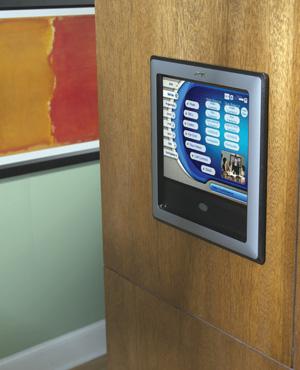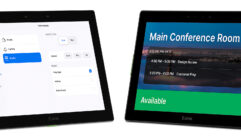

AV Takes Control
On March 29, 2008, 370 cities participated in Earth Hour. In many cases, that meant sending employees to each room to turn off light switches. There’s a better way. Why stop at just screen and sound? AV pros look for new business by automating clients’ lighting and HVAC systems, too.
DEFINING CONTROLROOMS FOR GROWTH
Credit: Courtesy AMX
ON MARCH 29, 2008, 370 CITIES around the world participated in Earth Hour, during which consumers and companies used as little electricity as possible. For large enterprises, the major challenge was turning off lights, shutting down displays, and adjusting thermostats in hundreds or thousands of rooms. In many cases, that meant sending employees to each room to flip switches.
Crazy as that sounds, some enterprises do just that the other 8,759 hours in a year.
One Fortune 500 company used to manage its AV equipment by having a staff of four drive to all 16 of its offices every weekday to ensure everything was up and running. To Richardson, Texas-based AMX, that didn’t seem like an efficient way to manage an AV infrastructure, so it pitched the company on its Resource Management Suite product, which lets users remotely monitor and manage AV and other devices from a central location.
“Now [the company] can put those resources on other things because these guys aren’t driving from building to building to make sure that the projector bulb still works and that the screen still comes down,” says Robert Noble, AMX’s chief technology officer.
Efficiency can be measured in other ways, too, creating opportunities for AV professionals. For instance, the same system used to remotely monitor AV devices could be used to dim the lights slightly or adjust the temperature a few degrees to trigger a discounted rate from the electric company. The company reduces its energy consumption and, in the case of new construction and major remodels, possibly meets Leadership in Energy and Environmental Design (LEED) benchmarks (www.usgbc.org/LEED). Such benefits are driving AV pros to consider systems that link AV, lighting, and HVAC, among other systems. After all, they already know best how to build the systems that control AV equipment. Why not branch out into whole-building automation?
“We had somebody tell us the other day, ‘Anything that I can put into my building that’s going to save me energy or money, I’ll spend the money today,'” Noble says.
Systems that put AV gear under the same control as other infrastructure span a wide variety of environments, from individual museum displays to an entire office building or campus. The common denominator is that they all often require knowledge of non-AV technologies and protocols, such as Building Automation and Control Network (BACnet), which was developed by the AmericanSociety of Heating, Refrigerating and Air-Conditioning Engineers [see “At a Glance: Control Protocols,” end of article].
One type of control is “macro” systems, where the user sets a series of pre-programmed actions in motion by pressing a button or triggering a sensor.
“For example, an exhibit at the Federal Reserve Bank educates visitors about the security features found in a hundred dollar bill,” says Glenn Polly, owner of VideoSonic, a New York City-based integrator. “A button labeled ‘press to start’ activates the audio narration, which begins by informing the visitor that there are several security features and describes the special paper the bill is printed on. Four seconds into the narration, a showcase containing a sheet of blank paper illuminates.” Over the next 2.5 minutes, more lights go on and off to spotligh other parts of the bill as they’re discussed.
“To prevent the visitor from re-triggering the sequence during the show, the push button is deactivated,” Polly says. “This is accomplishedby employing another relay in the controller that disengages the push button switch’s contacts for 2 minutes and 31 seconds—the duration of the show. This is a good example of how simple or complex intelligent logic programming can be accomplished with ‘dumb’ analog devices.”
Another example is a conference room, where the presenter hits just one buttonon a touch panel to automatically lower the shades and screen, dim the lights, lower the speed of the HVAC blower, turn on the projector, and launch the presentation.
“Controls over light dimming systems are quite common, [but] HVAC control is not,” says Darren Cheshier, CTS-D, an engineer at Conference Technologies, a St. Louis-based integrator. “Usually if they already have a dimming system and we are putting in a control system, we will control the lights. Motorized drapes and shades are quite common also.”
No matter how it’s defined, many vendors and integrators say that the control market is already a significant opportunity.
“It’s exploding,” says Randy Klein, executive vice president at Rockleigh, N.J.-based Crestron Electronics. “There are no verticals. There are only horizontals. It’s in every market in every sector.”
But some integrators see differences in interest and willingness to pay, often based on the space itself.
“Mostly boardrooms get these types of [AV and lighting] controls, but most conference rooms do not,” Cheshier says. “It’s usually the high-finish spaces. We also see this type of control for scripted presentation facilities. I think this type of control will continue to increase as people see them as standard and not as a luxury.”
Milwaukee-based Johnson Controls also sees differences in market opportunities.
“Owner-occupied office facilities and high-end retail are prime commercial opportunities, while the home automation market is generally thought to be ready to take off as soon as we get out of the construction slump,” says Terry Hoffmann, director of BAS marketing for the company’s building efficiency business division.
Another factor that can affect an enterprise’s interest is the age of its existing AV, lighting, and HVAC equipment. Older gear often lacks the interfaces necessary to be connected to a network. If the hardware still works fine, the enterprise might not be receptive to replacing it. They also may not be willing to spring for the cost of labor and materials to link all the devicesin a room or building. In those cases, short-range wireless technologies, such as Zig-Bee, may provide a low-cost alternative.
“It is much easier to control legacy devices with a simple plug-in device that communicates over the air than having to wire them,” Hoffmann says.
AV Takes Control
On March 29, 2008, 370 cities participated in Earth Hour. In many cases, that meant sending employees to each room to turn off light switches. There’s a better way. Why stop at just screen and sound? AV pros look for new business by automating clients’ lighting and HVAC systems, too.
UNDERSTANDING NUTS AND VOLTSADDING VALUE
Regardless of whether the installation uses wired or wireless connectivity, existing and new equipment must speak the same language.
“Some of the major HVAC and lighting manufacturers have BACnet gateways or Modbus gateways for their older systems,” says Greg Turner, director of global offerings at Morris Township, N.J.-based Honeywell Building Solutions. “So in many cases, there’s a single device that can be added to that old system to give it that open capability to talk to third-party devices.”
Some integrators say that they avoid working with certain types of equipment, such as stand-alone dimmers located at each wall switch.
“These types of dimmers require [a] voltage ramp control interface,” says Conference Technologies’ Cheshier. “I’m not sureif control manufacturers even still have these interface cards. If a client has these types of dimmers, we will tell them we cannot control them and recommend they either contract with an electrical contractor, or we can supply a dimming system and work with a electrical contractor.”
AT A GLANCE: CONTROL PROTOCOLS
BACnet www.bacnet.org Developed by the American Society of Heating, Refrigerating and Air-Conditioning Engineers in 1987, Building Automation and Control Network (BACnet) is a set of protocols in 30 countries, including the United States. BACnet defines a wide variety of commands and technical requirements, such as the type of cable that should be used for a particular application or the process of querying a device?asking a thermostat to gettemperature information, for example. Makers of lighting, HVAC, and AV gear can use BACnet to ensure interoperability between products, including those in a multi-vendor environment.
DALI www.dali-ag.org) The Digital Addressable Lighting Interface (DALI) protocol is designed to enable interoperability between lighting products from multiple vendors. A group of lighting industry manufacturers, AG-DALI, promotes the technology and issues a logo to compatible products, which include ballasts and transformers.
Modbus www.modbus.org Created in 1979 by what’s now Schneider Electric, the Modbus protocol now is shepherded by Modbus-IDA, an independent developer and user community. Modbus is an open standard that enables client-server relationships between devices?such as programmable logic controllers (PLCs), whichfacilitate automation in devices such as sensors. Modbus also is designed to work over wireless links, such as cellular.
ZigBee www.zigbee.org Created in 1998 as a response to perceived shortcomings of Bluetooth and 802.11 Wi-Fi, ZigBee is wireless technology with a range of about 250 feet. It’s designed for applications that require low power consumption, with a ZigBee radio capable of running a year or longer on battery power. It’s currently used for a wide variety of consumer and commercial applications, including home automation, building access control, and security monitoring.
Indeed, the ability to work with electricians, as well as knowledge of electrical basics, are major assets for integrators targeting the control market.
“The integrator needs to know how to calculate lamp loads and how to work with the electricians,” Cheshier says. “Most electrical contractors have not seen these types of dimming systems, so integrators have to know how to instruct the electricians where to connect the AC line voltage and how many circuits are needed.”
The type of project also can determine the types of companies the integrator must be able to work with. “If the project is a construction project, we have to work with architect, MEP [mechanical, electrical, and plumbing] engineer, electrical contractor, and the client,” Cheshier says. “If the project is a retrofit, we have to work with the client, their facilities department or the building owner facilities department, and an electrical contractor.”
Success in the control market also means knowing which people at a company to pitch to. Often they’re not the ones responsible for AV.
That’s what Crestron learned from working with Microsoft, which uses Crestron products for controlling AV and building systems at its headquarters. “When we talk to Microsoft, we’re not going to the AV guy,” Klein says. “We’re going to the real estate division, the people who build and run the buildings.”
Control ultimately is a subset of two trends in pro AV. The first is the convergence of AV and IT, where knowledge of IT basics such as Ethernet networking is a must if you’re going to convince a client’s IT manager that it’s okay to put a projector or light dimmer on the LAN. “I’ve seen meetings where you walk in, and the IT manager has his arms folded and a look like, ‘You’renot putting anything on my network,'” says AMX’s Noble.
That’s why AMX and others have courses for dealers on setting up and troubleshooting Wi-Fi LANs. An integrator that understands the difference between 2.4 GHz and 5 GHz Wi-Fi has more credibility in the eyes of an IT manager.
Control is also a part of the trend away from selling only hardware and installation and toward also selling services. If a customer is sold on a system that ties together AV and lighting, the integrator could use that to offer a service plan that remotely monitors all that equipment. “We have dealers who have bought into the idea of selling maintenance agreements,” Noblesays. “They know when a projector bulb has reached 80 percent of life or the DVD player has reached 100 hours and probably needs to be cleaned.”
If that system supports the Digital Addressable Lighting Interface (DALI) protocol, it could also be used to monitor and control fluorescent light fixtures. Either way, by identifying outages and other problems before they occur, the integrator looks proactive, which could help convince the client to stick with the company when they need more equipment.
Remote monitoring and control—whether it’s by the integrator or by the client’s own staff—also can help with security and safety. If all of the AV equipment in a boardroom suddenly loses its network connection, that might be a sign to alert security to look for a cart full of gear going down the hall.
Another example is linking the AV and lighting to the building’s fire systems so that when the alarm goes off, the lights are automatically brought up to full brightness, the loudspeakers are shut off so everyone can hear the alarm, and all displays show the emergency routes.
“We’re seeing more and more of that with our hotel customers,” says Honeywell’s Turner. “Those are great value-adds for integrators. They come in with a digital signage solution and say, ‘We can also use this to enhance the safety of this [facility].’ It’s a nice extra that they can sell and get some additional margin from.”
Tim Kridel is a Columbia, Mo.-based freelance writer and analyst who covers telecom and technology. He can be reached at [email protected].










